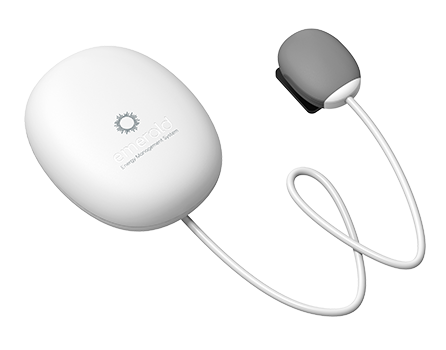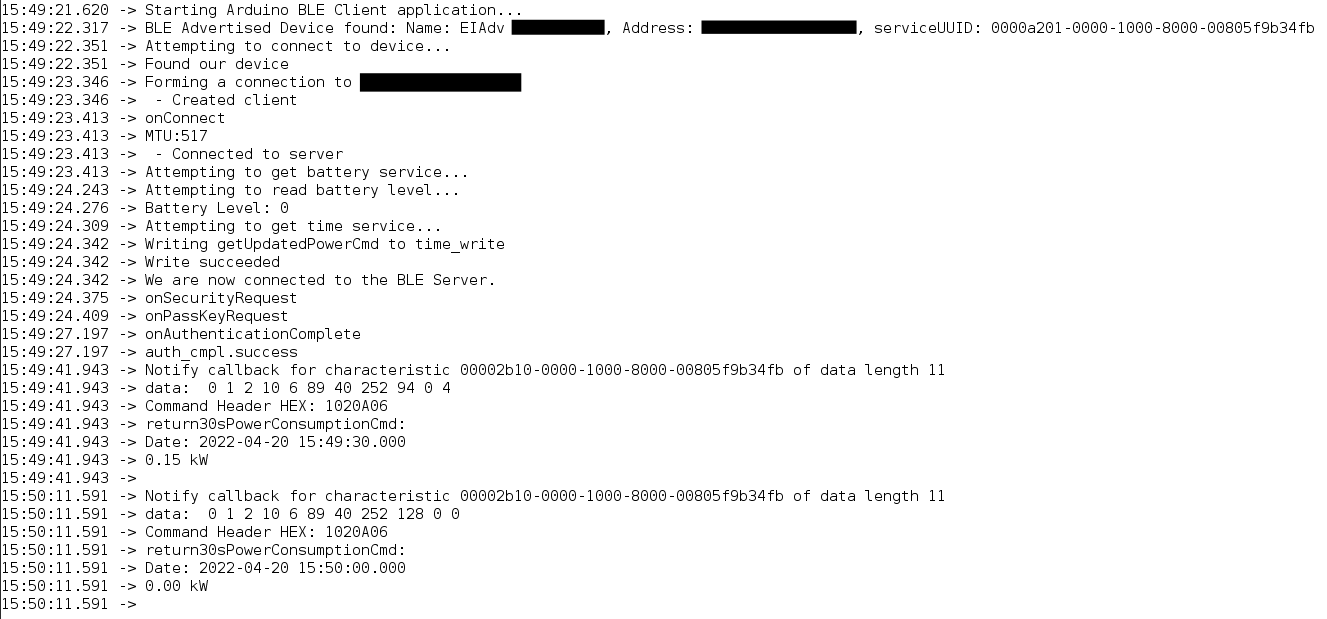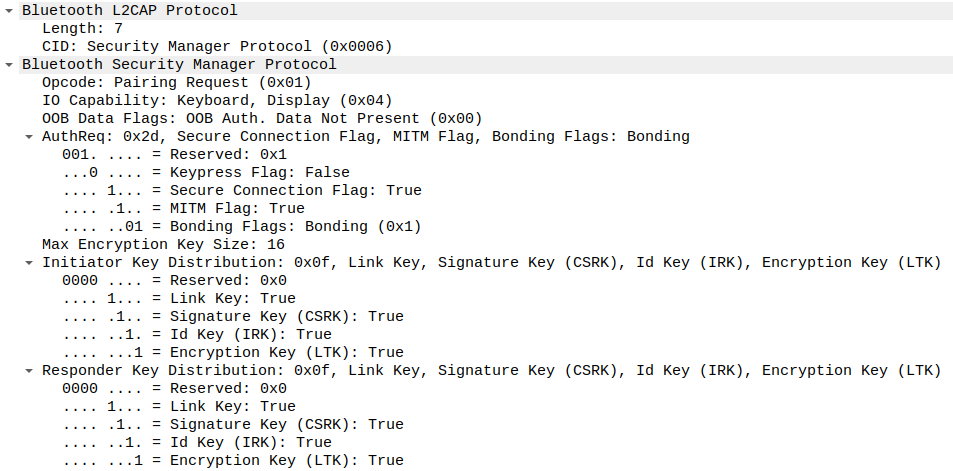This repository is not affiliated with Emerald.
Collection of code, tools and documentation for data retrieval from your Emerald Electricity Advisor (all reverse engineered)
The ESPHome component hasn't been merged into esphome yet, but you can use it via external_components
- An ESP32
- A configured Emerald Electricity Advisor
- Electricity Advisor device information:
- BLE MAC address (can be found on device sticker, by running sketch, or by using an app like nRF Connect once you have disabled the bluetooth of all your smart devices)
- Connection pairing pin (6 digits you input when setting up your device, also can be found on device sticker (last 6 digits of serial))
- Your Smart meter pulse rate (eg. 1000 pulses = 1kW/h)
external_components:
- source: github://WeekendWarrior1/esphome@emerald_ble
# requires ble_client and ble_tracker because I had to add some small features to authenticate properly
components: [ ble_client, esp32_ble_tracker, emerald_ble ]
# optional requirement used with daily energy sensor
time:
- platform: homeassistant
id: homeassistant_time
esp32_ble_tracker:
ble_client:
- mac_address: 30:1B:97:01:02:03
id: emerald_advisor
sensor:
- platform: emerald_ble
ble_client_id: emerald_advisor
power:
name: "Emerald Power"
daily_energy:
name: "Emerald Daily Energy"
energy:
name: "Emerald Total Energy"
battery_level:
name: "Emerald Battery"
pairing_code: 123123
pulses_per_kwh: 1000
time_id: homeassistant_time # daily energy still works without a time_id, but recommended to include one to properly handle daylight savings, etc.You can also find a full config here: emerald_ble.yaml
And the component code here: emerald_ble ESPHome Component
This sketch simply prints the energy usage and time stamp for the updates sent by the Electricity Advisor, which should be received every 30s.
It's mainly useful to demonstrate that the Electricity Advisor is connectable by a third party device.
Of interest in the sketch is the security configuration required to pair/handshake with the Electricity Advisor, which may limit what BLE technologies, libraries and languages you can use to connect (not every library seems to support secure BLE connections)
- An ESP32
- A configured Emerald Electricity Advisor
- Electricity Advisor device information:
- BLE MAC address (can be found on device sticker, by running sketch, or by using an app like nRF Connect once you have disabled the bluetooth of all your smart devices)
- Connection pairing pin (6 digits you input when setting up your device, also can be found on device sticker (last 6 digits of serial))
- Your Smart meter pulse rate (eg. 1000 pulses = 1kW/h)
static char *BLE_address("30:1b:97:00:00:00"); // lowercase only or else will fail to match
// if your pairing pin starts with 0, eg "024024", set the emerald_pass_key as 24024
static uint32_t emerald_pass_key = 123123;
static float pulses_per_kw = 1000;If you would prefer to use the cloud api rather than retrieving real-time data from the Electricity Advisor, please head to api_documentation to learn how to authenticate and retrieve energy data.
Feel free to import the postman collection if you would like to have a play or to investigate the data you can retrieve:
Import (ctrl+o in postman), > link > Enter a URL https://raw.githubusercontent.com/WeekendWarrior1/emerald_electricity_advisor/main/emerald-ems.postman_collection.json > Continue
TIME_SERVICE_UUID: "00001910-0000-1000-8000-00805f9b34fb"
// Subscribe to notifications on this characteristic for all the Emerald energy information. Data comes back with a descriptive 5 byte command header
READ_CHAR_UUID: "00002b10-0000-1000-8000-00805f9b34fb"
// Write commands to this characteristic to change Emerald Advisor settings or retrieve energy data
WRITE_CHAR_UUID: "00002b11-0000-1000-8000-00805f9b34fb"getImpulseCmd = "0001010500";
getPairingCodeCmd = "0001030100";
getEvery30sPowerConsumptionCmd = "0001020306";
getDeviceTimeCmd = "0001010200";
getUpdatedPowerCmd = "0001020100";
getEvery30sPowerConsumptionCmdWitninHours = "0001021308";
// Set pulses_per_kwh, with 2 bytes after the command
// eg. 000101040203E8 <- (1000 in hex = 03E8)
setImpulseCmd = "0001010402";
startGettingHistoryCmd = "0001020400";
endGettingHistoryCmd = "0001020600";
setDeviceTimeCmd = "0001010104";
resetCmd = "0001010a00";
// Enable automatic upload of pulses (every 30s)
// eg. 0001020b0101 <- (true in hex = 01)
setAutoUploadStatusCmd = "0001020b01";
return30sPowerConsumptionCmd = "0001020a06";
returnUpdatedPowerCmd = "0001020204";
returnEvery30sPowerConsumptionCmd = "000102050e";
returnImpulseCmd = "0001010602";
returnPairingCodeCmd = "0001030206";
returnDeviceTimeCmd = "0001010304";The Emerald has reasonably strict authentication requirements:
On an ESP32 I needed to set:
esp_ble_io_cap_t iocap = ESP_IO_CAP_KBDISP;
esp_ble_gap_set_security_param(ESP_BLE_SM_IOCAP_MODE, &iocap, sizeof(esp_ble_io_cap_t));
uint8_t key_size = 16;
esp_ble_gap_set_security_param(ESP_BLE_SM_MAX_KEY_SIZE, &key_size, sizeof(uint8_t));
esp_ble_auth_req_t auth_req = ESP_LE_AUTH_REQ_SC_MITM_BOND;
esp_ble_gap_set_security_param(ESP_BLE_SM_AUTHEN_REQ_MODE, &auth_req, sizeof(esp_ble_auth_req_t));After connecting, the Emerald Advisor will request the passkey from your device, which will depend on your BLE library how you respond:
// arduino callback
class MySecurityCallback : public BLESecurityCallbacks
{
bool onSecurityRequest() {
return true; // Return true if we accept this peer device auth request
}
uint32_t onPassKeyRequest() {
return 123123;
}
}
// esp-idf
switch (event) {
case ESP_GAP_BLE_SEC_REQ_EVT: // Return true if we accept this peer device auth request
esp_ble_gap_security_rsp(param->ble_security.ble_req.bd_addr, true);
break;
case ESP_GAP_BLE_PASSKEY_REQ_EVT: /* passkey request event */
esp_ble_passkey_reply(param->ble_security.ble_req.bd_addr, true, 123123);
break;
}Authentication is now complete, so time to enable setAutoUploadStatusCmd:
uint8_t enable_auto_upload[] = {0x00, 0x01, 0x02, 0x0b, 0x01, 0x01};
pRemoteCharacteristic_readingbatchsize->writeValue(enable_auto_upload, sizeof(enable_auto_upload), false);Subscribe to Emerald Advisor notifications:
pRemoteCharacteristic_time_read = pRemoteService_time->getCharacteristic(CHAR_TIME_READ_UUID);
pRemoteCharacteristic_time_read->registerForNotify(emeraldCommandCallback);Parse incoming Emerald Advisor notifications:
// incoming data
// pData = [0 1 2 10 6 89 55 105 158 0 12]
// first 5 bytes (0-4) are the Emerald Command Header, which describes the data
uint32_t commandHeader = 0;
for (int i = 0; i < 5; i++) {
commandHeader += (pData[i] << (8*(4-i)));
}
// pData [0 1 2 10 6] = 0001020a06, command header return30sPowerConsumptionCmd
// next 4 bytes (5-8) are an oddly formatted timestamp (I'm guessing either for obfuscation or to avoid the Year 2038 unix-timestamp problem)
uint32_t commandDateBin = 0;
for (int i = 5; i < 9; i++) {
commandDateBin += (pData[i] << (8*(8-i)));
}
// (6 bits)year + (4 bits)month + (5 bits)days + (5 bits)hours(locale adjusted) + (6 bits)minutes + (6 bits)seconds
uint16_t year = 2000 + (commandDateBin >> 26); // need to add 2000 to get the correct year
uint8_t month = ((commandDateBin >> 22) & 0b1111); // month number between 1 - 12
uint8_t days = ((commandDateBin >> 17) & 0b11111); // 1-31
uint8_t hours = ((commandDateBin >> 12) & 0b11111); // 0-23
uint8_t minutes = ((commandDateBin >> 6) & 0b111111); // 0 -59
uint8_t seconds = commandDateBin & 0b111111; // 0 -59
// last 2 bytes (9+10) are the pulses within the time interval window (30s)
uint16_t pulses_within_interval = data[9] << 8;
pulses_within_interval += + data[10];

